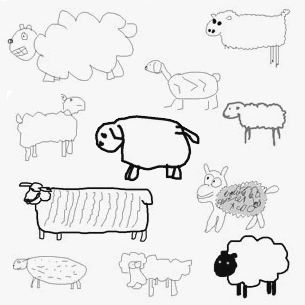 Here to report on the opening gala for Gray Area Beacon, a new multimedia gallery and the brainchild of my brilliant friend Josette (of Gray Area Gallery/Hear Gallery fame). It was a fabulous show, and not just because of the strong showing of high-tech works by featured artist Aaron Koblin in his first San Francisco show. Looking around and taking in the gallery, a freshly-converted SOMA garage still smelling of paint and sweat, there was a palpable feeling of collaborative accomplishment and (well-earned) pride shared by the bash's hosts as well as the intimate gathering of attendees. Here is a perfect example of a small group of motivated people, dedicated to creating a forum to showcase something they believe in, and building it from scratch. I was dazzled and inspired.
Here to report on the opening gala for Gray Area Beacon, a new multimedia gallery and the brainchild of my brilliant friend Josette (of Gray Area Gallery/Hear Gallery fame). It was a fabulous show, and not just because of the strong showing of high-tech works by featured artist Aaron Koblin in his first San Francisco show. Looking around and taking in the gallery, a freshly-converted SOMA garage still smelling of paint and sweat, there was a palpable feeling of collaborative accomplishment and (well-earned) pride shared by the bash's hosts as well as the intimate gathering of attendees. Here is a perfect example of a small group of motivated people, dedicated to creating a forum to showcase something they believe in, and building it from scratch. I was dazzled and inspired. Some standout works included The Sheep Market, a collaborative drawing project where Koblin collected digital drawings from countless participants after giving them only these terse instructions: Please draw a sheep facing to the left. The result is a large scale, ever-changing projection of line drawings which is simple, yet totally hypnotic. It was like counting sheep for the laziest insomniac.
 Koblin also showed his reconstructed $100 bill, a project in which he broke down the C-note into thousands of pieces so small as to be unrecognizable as part of the original. He sent these units out to participants who were to draw a likeness of what they saw and send it back. An image of the bill, reconstructed from its new constituents, was on exhibition as part of the show.
Koblin also showed his reconstructed $100 bill, a project in which he broke down the C-note into thousands of pieces so small as to be unrecognizable as part of the original. He sent these units out to participants who were to draw a likeness of what they saw and send it back. An image of the bill, reconstructed from its new constituents, was on exhibition as part of the show.

Also showing was a breathtaking light show of a map, exploring Koblin's interest in technology and human systems. The display simply tracked flight patterns across America throughout a day. But the more I looked at it, the less it seemed like what it was. The flashing lights and dynamic, organic rhythm could easily have been neurons firing in a baby's brain, or a fluorescent spiderweb being spun at hyper-speed.
 Koblin also showed his reconstructed $100 bill, a project in which he broke down the C-note into thousands of pieces so small as to be unrecognizable as part of the original. He sent these units out to participants who were to draw a likeness of what they saw and send it back. An image of the bill, reconstructed from its new constituents, was on exhibition as part of the show.
Koblin also showed his reconstructed $100 bill, a project in which he broke down the C-note into thousands of pieces so small as to be unrecognizable as part of the original. He sent these units out to participants who were to draw a likeness of what they saw and send it back. An image of the bill, reconstructed from its new constituents, was on exhibition as part of the show.
Also showing was a breathtaking light show of a map, exploring Koblin's interest in technology and human systems. The display simply tracked flight patterns across America throughout a day. But the more I looked at it, the less it seemed like what it was. The flashing lights and dynamic, organic rhythm could easily have been neurons firing in a baby's brain, or a fluorescent spiderweb being spun at hyper-speed.
As far as I know, Koblin's main focus with this piece was on the human level, but it's one more experience that reminds me that the same forces that operate on a micro level govern the macro as well.
(While I'm on this tangent, check out the short film The Powers of Ten made by Charles and Ray Eames. I just watched it again and I still enjoy it as much as I did in the 4th grade when I first saw it!)


No comments:
Post a Comment